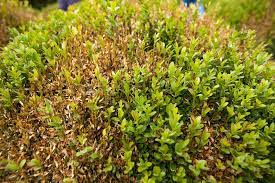PROBLEMS WITH BOX TREE CATERPILLAR AND BLIGHT
Box tree, otherwise known as Buxus Sempervirens, are an incredibly popular plant in the United Kingdom.
Unfortunately Box Tree Caterpillar and Blight are rife in the United Kingdom. What started in London and the surrounding areas has now spread all over the UK.
Although you can tackle Caterpillar and Blight sufficiently, it does take a lot of work and constant checks to keep it under control.
So much so gardeners are switching to various alternatives for more trouble free gardening.
The joy of box is how easily it can be shaped into almost anything making it a perfect Topiary option. This along with a relatively low cost makes it a firm favourite.
And although problems with Box Tree Caterpillar and Blight exist we do feel, if you have the time to invest, then persevering is worth while.
We decided to detail the characteristics along with some helpful tips to help you along.
BOX TREE CATERPILLAR AND BLIGHT CHARACTERISTICS.
CATERPILLAR
Gardeners are likely to become aware of the problems with box tree caterpillar when they find webbing and caterpillars on box plants.
The pale yellow flattish eggs are laid sheet-like, overlapping each other on the underside of box leaves.
Newly hatched caterpillars are greenish-yellow, with black heads.
Older caterpillars reach up to 4cm (1¼in) in length and have a greenish/yellow body with thick black and thin white stripes along the length of the body
The pupae are concealed in a cocoon of white webbing spun among leaves and twigs.
The adult moth usually has white wings with a faintly iridescent brown border, although the wings can be completely brown or clear.
The moth has a wingspan of around 4cm (1¼in).
The caterpillars eat box leaves and produce webbing over their feeding area.
Plants may also show patches of dieback which may be especially apparent on trimmed plants.
Where practical, caterpillars should be removed by hand.
There have been reports of birds such as blue tits feeding on the caterpillars in some locations.
BLIGHT
Box Blight is a box leaf diseased caused by the fungus Cylindrocladium Buxicola.
The disease, if not spotted early, can spread throughout the garden affecting all Buxus plants.
The leaves will display black/brown spots with black streaks on the stem and will ultimately fall.
It is recommended that certain measures are put in place to prevent the spread of the disease:
Create spaces between box planting to allow the air to flow freely and stop the Pathogen spreading.
Drip irrigation is better so avoid overhead watering which may leave the plant damp for long periods of time.
Clean garden tools with a garden disinfectant and, if you have a gardener, make sure they clean their shoes and tools between gardens.
Adding a Mulch - we recommend Top Buxus Carpet - to the top of the soil to reduce any rain splash.
If you are affected by Blight then Top Buxus Xen Tari is a treatment that has proved to be effective.
RHS/Royal Horticultural Society
Because of the popularity of Buxus and the devastating problems attached to them, the RHS have given guidance on how to tackle the problem.
Here is a fact sheet with further details: RHS Box-Tree-Moth-Caterpillar.
ALTERNATIVES
If you are affected by Box Tree Caterpillar or Blight and do not have the time to deal with the issues or the subsequent care needed, here is a link to our advice page regarding alternatives. We have a few suggestions for you, along with their associated problems, so you can make an informed decision.
Contact us
If you do have concerns but are not sure whether you are affected, please contact us either by telephone or email.
Please feel free to send over an image for us to take a look at.








